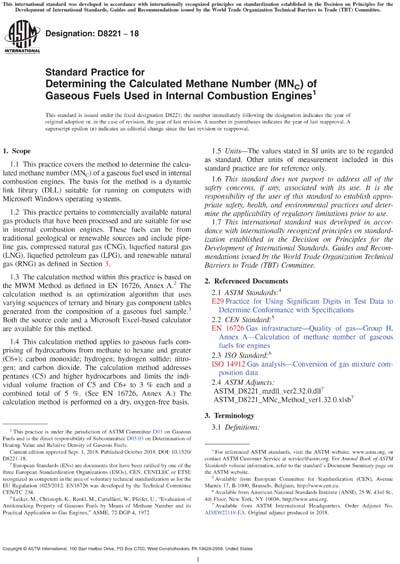Historical
ASTM D8221-18
Standard Practice for Determining the Calculated Methane Number (MNC ) of Gaseous Fuels Used in Internal Combustion Engines
1.1 This practice covers the method to determine the calculated methane number (MNC) of a gaseous fuel used in internal combustion engines. The basis for the method is a dynamic link library (DLL) suitable for running on computers with Microsoft Windows operating systems.
1.2 This practice pertains to commercially available natural gas products that have been processed and are suitable for use in internal combustion engines. These fuels can be from traditional geological or renewable sources and include pipeline gas, compressed natural gas (CNG), liquefied natural gas (LNG), liquefied petroleum gas (LPG), and renewable natural gas (RNG) as defined in Section 3.
1.3 The calculation method within this practice is based on the MWM Method as defined in EN 16726, Annex A.2 The calculation method is an optimization algorithm that uses varying sequences of ternary and binary gas component tables generated from the composition of a gaseous fuel sample.3 Both the source code and a Microsoft Excel-based calculator are available for this method.
1.4 This calculation method applies to gaseous fuels comprising of hydrocarbons from methane to hexane and greater (C6+); carbon monoxide; hydrogen; hydrogen sulfide; nitrogen; and carbon dioxide. The calculation method addresses pentanes (C5) and higher hydrocarbons and limits the individual volume fraction of C5 and C6+ to 3 % each and a combined total of 5 %. (See EN 16726, Annex A.) The calculation method is performed on a dry, oxygen-free basis.
1.5 Units—The values stated in SI units are to be regarded as standard. Other units of measurement included in this standard practice are for reference only.
1.6 This standard does not purport to address all of the safety concerns, if any, associated with its use. It is the responsibility of the user of this standard to establish appropriate safety, health, and environmental practices and determine the applicability of regulatory limitations prior to use.
1.7 This international standard was developed in accordance with internationally recognized principles on standardization established in the Decision on Principles for the Development of International Standards, Guides and Recommendations issued by the World Trade Organization Technical Barriers to Trade (TBT) Committee.
Content Provider
ASTM International [astm]






